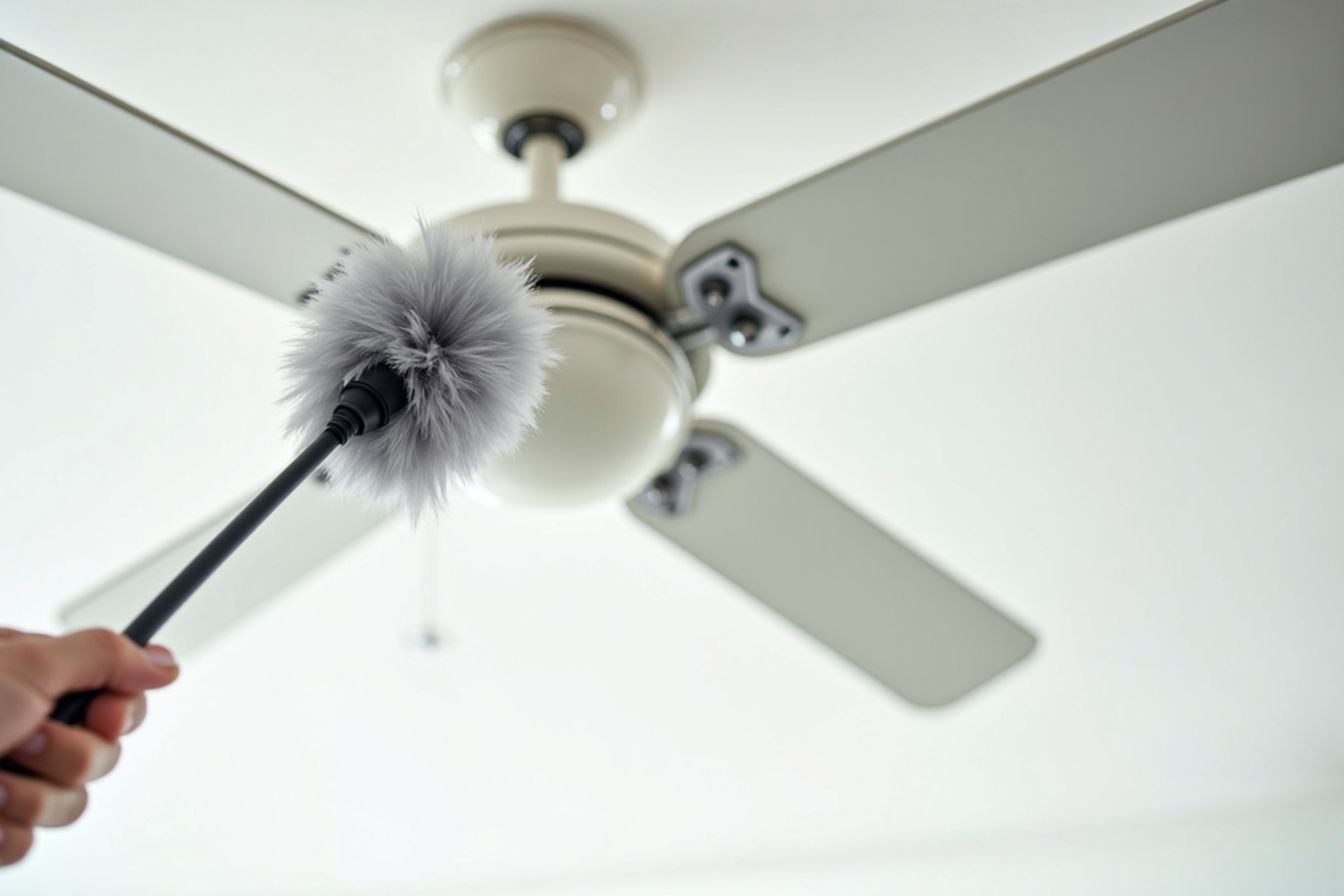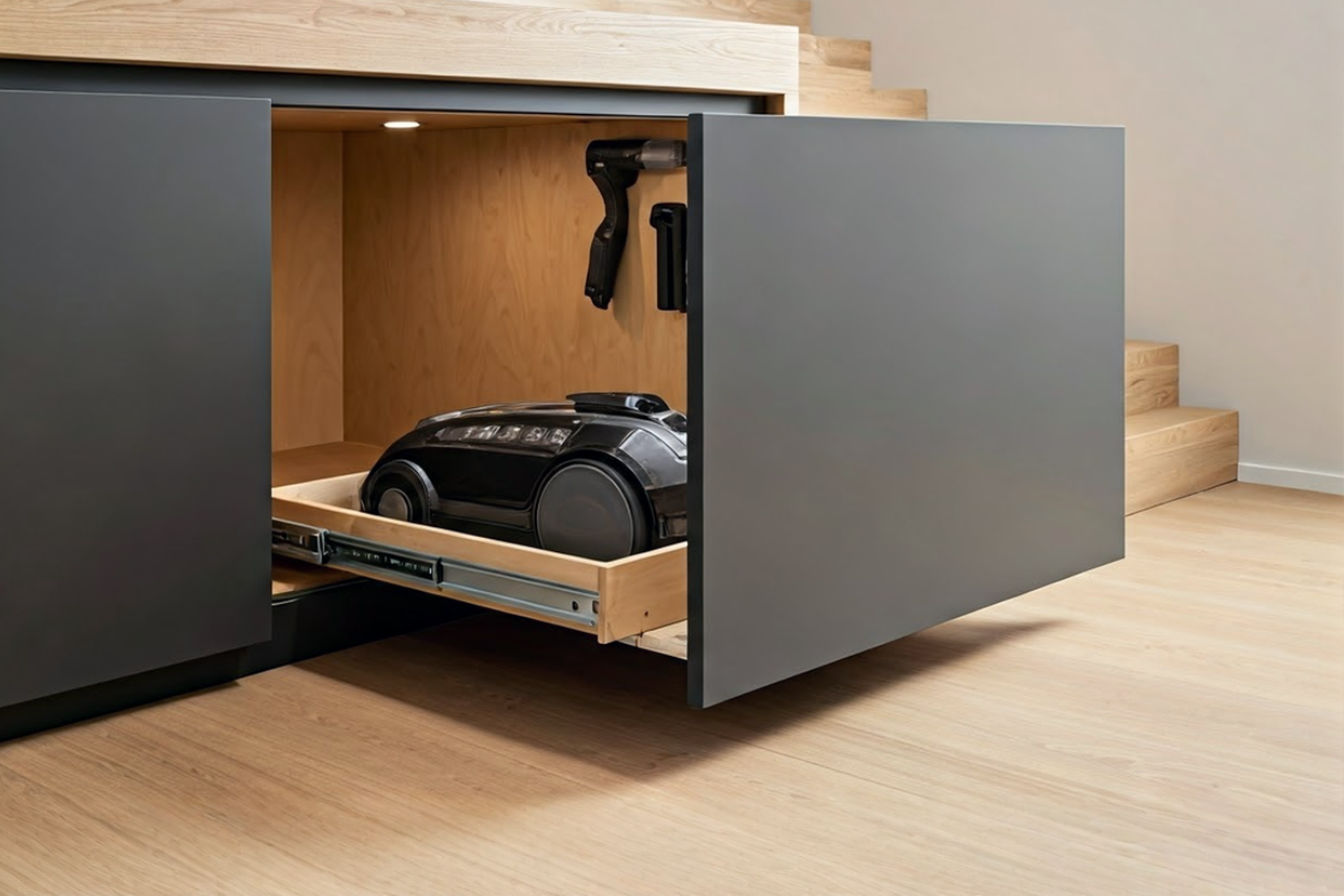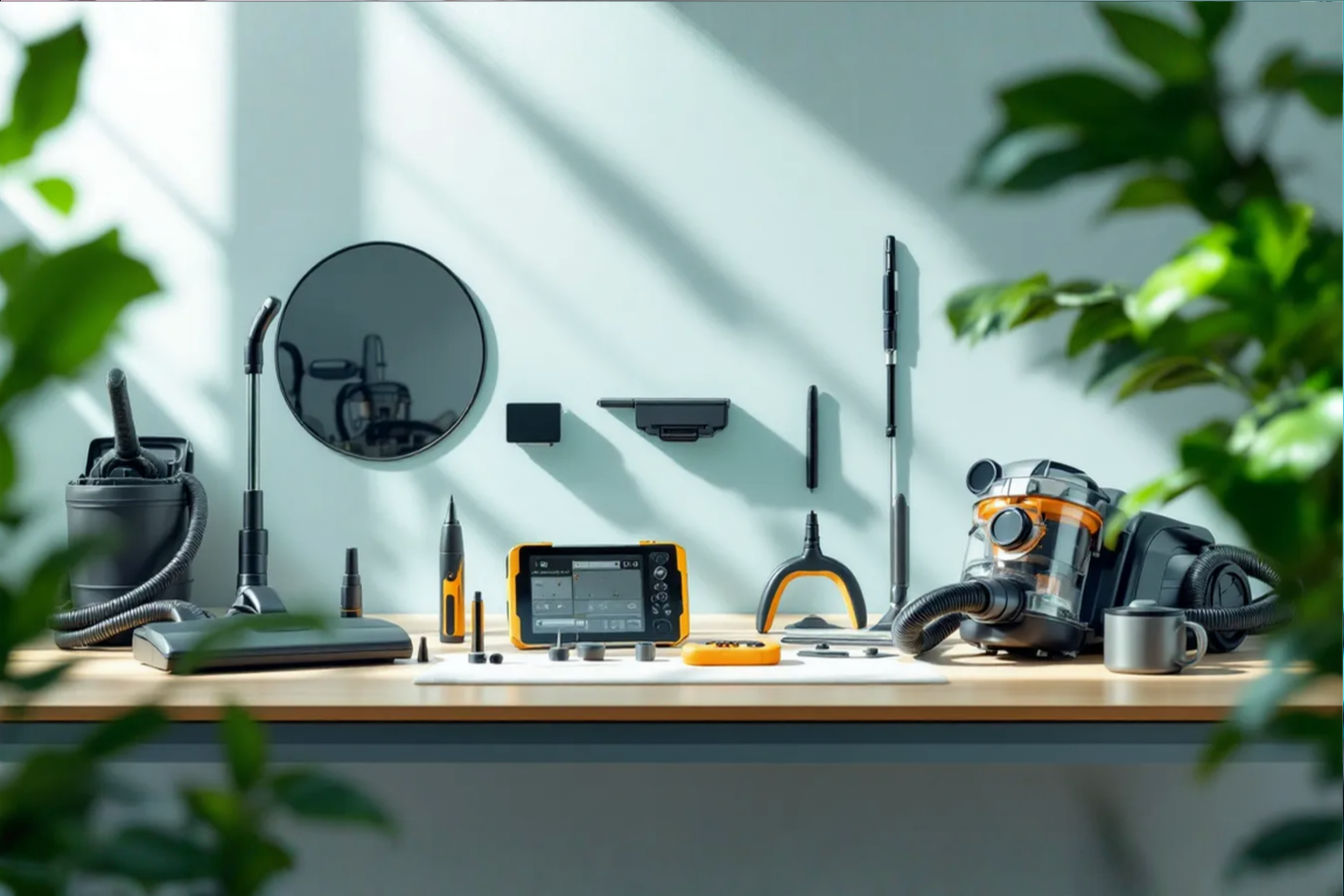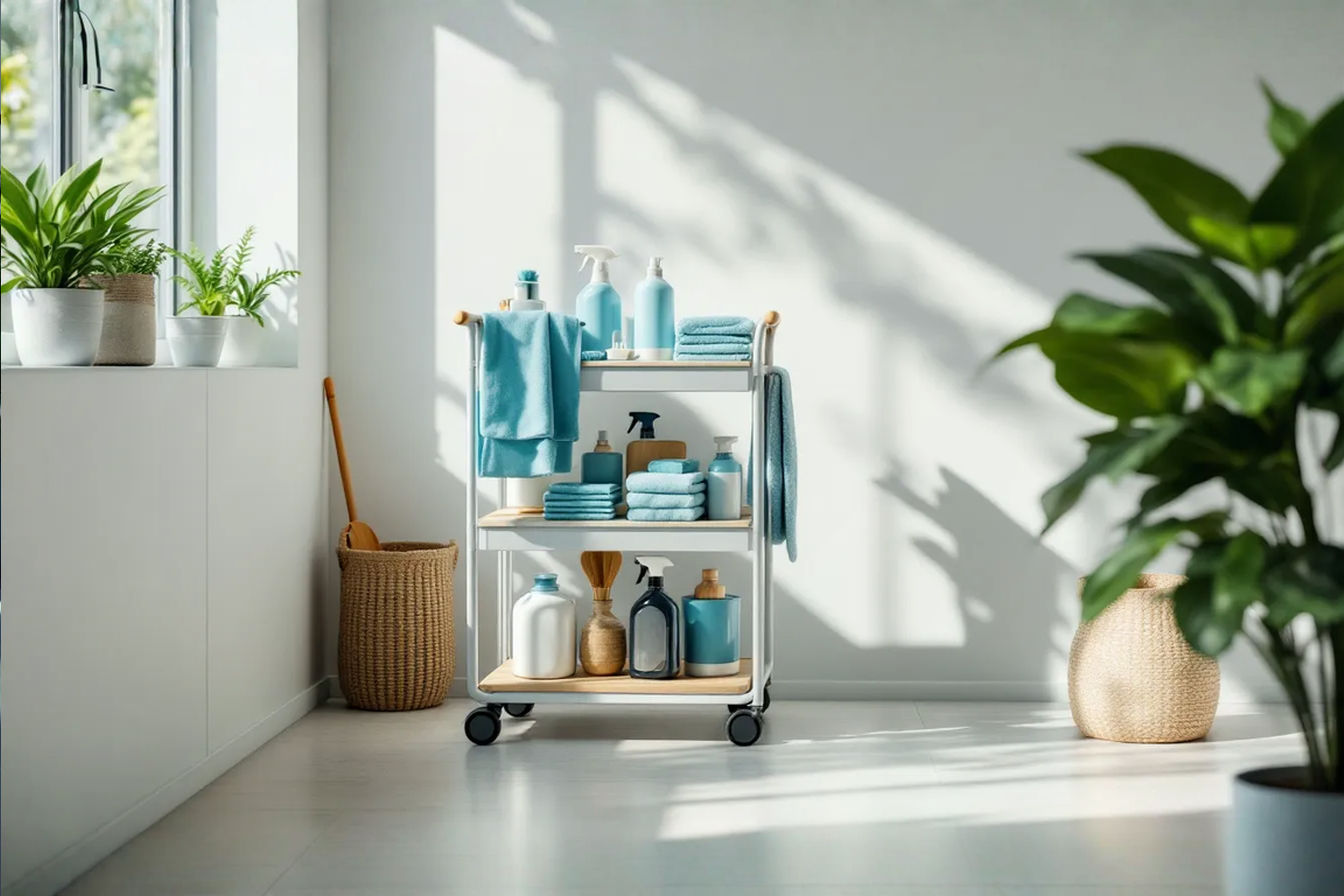Electrostatic Dusters as Vacuum Complements: Reaching Where Vacuums Can’t
Traditional vacuums can’t reach every dusty corner of your home. Learn how electrostatic dusters fill this critical cleaning gap and why the perfect cleaning strategy uses both tools.
This post may contain affiliate links. If you make a purchase through these links, we may earn a commission at no additional cost to you.
In the quest for a spotless home, many cleaning enthusiasts find themselves frustrated by those stubborn dust particles that seem to defy even the most powerful vacuum cleaners. Ceiling fan blades, electronic screens, ornate picture frames, and other intricate surfaces often remain dusty despite your best vacuuming efforts. This persistent challenge has created a need for complementary cleaning tools that address these specific limitations. Among these tools, electrostatic dusters have emerged as essential allies in the battle against dust, reaching places where traditional vacuums simply cannot go.
Modern cleaning requires a strategic approach that combines different tools for optimal results. Just as a painter wouldn’t rely on a single brush size for an entire canvas, effective home cleaning demands specialized instruments for different surfaces and spaces. This article explores how electrostatic dusters serve as perfect partners to vacuum cleaners, creating a comprehensive cleaning system that leaves no corner untouched and no surface unpolished.
Understanding Electrostatic Dusters
What Are Electrostatic Dusters?
Electrostatic dusters are specialized cleaning tools designed to attract and capture dust particles through the principles of static electricity. Unlike traditional feather dusters that merely push dust around, these innovative cleaners actively grab and hold onto dust, pollen, pet hair, and other microscopic debris. Their design typically features a handle coupled with a dusting head made from materials specifically engineered to generate static charge during use.
The dusting heads come in various shapes and sizes, from flat flexible wands that slide under appliances to extended poles that reach ceiling corners and fan blades. Some models feature replaceable dusting heads, while others are designed to be washed and reused. The versatility of these tools makes them invaluable additions to any cleaning arsenal, especially for those hard-to-reach areas that vacuum cleaners cannot effectively address.
The Science Behind Static Electricity and Dust Attraction
The effectiveness of electrostatic dusters relies on basic principles of physics. Dust particles typically carry a slight positive charge, while the specially designed fibers in electrostatic dusters develop a negative charge when moved across surfaces. This charge differential creates an attraction that pulls dust toward the duster fibers, similar to how a balloon rubbed against hair will stick to a wall.
This scientific principle gives electrostatic dusters their remarkable ability to collect dust rather than redistribute it. The specialized synthetic fibers used in these dusters can hold onto captured particles until they are washed or shaken out, preventing the common problem of dust simply becoming airborne again during cleaning.
Types of Electrostatic Dusters Available
The market offers several variations of electrostatic dusters to address different cleaning needs:
Disposable dusting systems feature replaceable heads that can be discarded when full. These provide convenience but generate ongoing waste and replacement costs.
Washable electrostatic dusters typically use microfiber technology that can be rinsed and reused hundreds of times. These environmentally friendly options provide long-term value despite higher initial costs.
Extendable models come with telescoping handles that can reach ceiling corners, tops of cabinets, and other elevated surfaces without requiring ladders or stretching.
Specialized shapes address particular cleaning challenges, such as blind cleaners, ceiling fan dusters, and flexible wands for cleaning under and behind furniture.
Each type serves specific purposes in a comprehensive cleaning strategy, complementing the strengths of vacuum cleaners while addressing their inherent limitations.
The Limitations of Vacuum Cleaners
Common Areas Vacuums Struggle to Clean Effectively
Even the most advanced vacuum cleaners encounter significant challenges when tasked with certain cleaning scenarios. Electronic equipment, with its sensitive components and numerous crevices, often remains dusty after vacuuming. Similarly, delicate objects such as collectibles, artwork, and fragile decorative items risk damage from powerful vacuum suction. Plants, books, and paper materials present their own challenges, as vacuums may damage leaves or pages while attempting to remove dust.
Ceiling corners, crown molding, and high shelving typically remain beyond the reach of standard vacuums, collecting dust that eventually falls to lower surfaces. Intricate furniture details and tight spaces between objects frequently harbor dust that vacuum attachments cannot effectively access. These limitations aren’t flaws in vacuum design but rather inherent constraints of an appliance primarily developed for floor cleaning.
Why Design Constraints Limit Vacuum Functionality
Vacuum cleaners excel at their primary purpose: removing debris from floors and carpets. Their design prioritizes strong suction, effective filtration, and maneuverability across large floor surfaces. This specialized focus necessarily creates trade-offs that limit their effectiveness in other cleaning scenarios.
The size and weight that give vacuums their cleaning power make them unwieldy for precision tasks or extended overhead use. Their rigid construction, while necessary for durability, prevents them from conforming to irregular shapes or accessing tight spaces. Even with attachments, vacuums struggle with extremely narrow gaps, intricate ornamentation, and electronic equipment that could be damaged by strong suction.
Additionally, the noise and disruption of vacuum operation makes them impractical for quick touch-ups or cleaning while others are sleeping, working, or enjoying entertainment in the home. These inherent limitations create natural opportunities for complementary tools like electrostatic dusters.
The Dust That Vacuums Leave Behind
Despite impressive marketing claims, vacuums inevitably miss certain types of dust. Microscopic particles often pass through less efficient vacuum filters, returning to the air only to settle again later. Static-prone surfaces like electronics and plastic materials may actually repel dust during vacuuming, making collection more difficult. Fine dust on vertical surfaces often slides down before vacuum attachments can capture it.
Environmental factors compound these challenges. Dry conditions increase static electricity, making dust cling more stubbornly to surfaces. High humidity can cause dust to adhere more firmly through moisture. Either condition can reduce vacuum effectiveness, leaving residual dust that detracts from home cleanliness and may contribute to respiratory irritation.
This residual dust represents not just an aesthetic problem but potentially a health concern, especially for allergy sufferers. The limitations of vacuums in completely removing this dust create a clear need for complementary tools designed specifically to address these remaining particles.
How Electrostatic Dusters Fill the Cleaning Gap
Reaching High and Narrow Spaces
Electrostatic dusters excel precisely where vacuums fall short—in accessing difficult-to-reach areas of the home. Their lightweight design makes overhead cleaning effortless, allowing users to dust ceiling fans, light fixtures, and tall bookshelves without strain. The flexible nature of many dusting heads enables them to conform to irregular shapes and surfaces, cleaning thoroughly where rigid vacuum attachments cannot reach.
Extended handles on modern electrostatic dusters can reach heights of 10 feet or more, eliminating the need for ladders in most residential settings. This extended reach not only improves cleaning effectiveness but also enhances safety by keeping feet firmly on the ground. The slim profile of dusting wands slips easily between furniture pieces, behind electronics, and into narrow gaps that defeat even the most specialized vacuum attachments.
This exceptional access to challenging areas ensures that dust cannot accumulate in forgotten corners, eventually to be disturbed and redistributed throughout living spaces. By regularly addressing these hard-to-reach areas with an electrostatic duster, homeowners can maintain cleaner air and surfaces throughout their homes.
Cleaning Delicate Surfaces and Objects
Many precious items in our homes require gentler treatment than vacuums can provide. Electrostatic dusters offer the perfect solution for these delicate cleaning tasks. The soft fibers move gently across surfaces without scratching, making them ideal for dusting electronics, screens, artwork, and collectibles. Unlike vacuums, which can potentially damage sensitive items with powerful suction, electrostatic dusters remove dust with minimal contact pressure.
The absence of mechanical parts and motors makes these dusters completely safe for use around water-sensitive electronics. Their gentle operation preserves the integrity of antique finishes, painted surfaces, and delicate fabrics that might otherwise be damaged by more aggressive cleaning methods. This gentleness extends the lifespan of valuable items while maintaining their appearance and function.
For households with extensive collections of books, figurines, or other display items, electrostatic dusters provide efficient cleaning without the need to move each object individually. Their flexibility allows them to navigate around items on shelves, removing dust without disrupting carefully arranged displays.
Addressing Static-Prone Areas
Ironically, the same physical principle that makes electrostatic dusters effective—static electricity—creates cleaning challenges in many modern homes. Electronic equipment, plastic surfaces, and synthetic materials naturally develop static charges that actively attract and hold dust particles. Conventional vacuum attachments often struggle to overcome this attraction, leaving visible dust even after cleaning.
Electrostatic dusters turn this challenge into an advantage by using an even stronger charge to pull dust away from these surfaces. The specialized fibers effectively overcome the existing static bond, transferring dust from the surface to the duster. This capability makes these tools particularly valuable for cleaning computer equipment, entertainment centers, plastic storage containers, and synthetic upholstery.
By regularly removing dust from static-prone surfaces, electrostatic dusters not only improve appearance but also help prevent dust-related issues with electronic equipment. Less dust on cooling vents and heat sinks can contribute to better performance and longevity of valuable devices throughout the home.
Quick Touch-ups Between Deep Cleanings
Few homeowners have time for comprehensive cleaning sessions daily, yet dust accumulates continuously. Electrostatic dusters bridge this gap by enabling quick, targeted cleaning with minimal preparation and cleanup. Their quiet operation allows for dusting even when family members are sleeping or working nearby, and their lack of cords or motors means no setup time is required.
This convenience makes electrostatic dusters ideal for addressing visible dust as it appears, rather than waiting for scheduled cleaning sessions. The ability to perform rapid touch-ups maintains cleaner surfaces throughout the week, reducing overall dust buildup and making deep cleaning sessions more effective and less time-consuming.
The psychological benefit of this quick-response capability shouldn’t be underestimated. The satisfaction of immediately addressing visible dust contributes to a greater sense of control over the home environment and reduces the feeling of constantly fighting a losing battle against dust accumulation.
The Perfect Pairing: Using Vacuums and Dusters Together
Optimal Cleaning Sequence
Creating an effective cleaning strategy means understanding how to best combine electrostatic dusters with vacuum cleaners. The most efficient approach typically begins with dusting high surfaces first, working from top to bottom throughout the space. This sequence takes advantage of gravity, as loosened dust particles naturally fall to lower surfaces where they can be captured during subsequent cleaning steps.
Start by using the electrostatic duster on ceiling corners, light fixtures, and high shelving. Move methodically to mid-level surfaces such as picture frames, window treatments, and furniture tops. After these higher surfaces are addressed, vacuum floors and upholstery to capture any fallen dust. This systematic approach prevents recontamination of already-cleaned areas and maximizes efficiency.
For particularly dusty environments, consider using electrostatic dusters to clean lampshades, electronics, and other dust-prone items before vacuuming nearby surfaces. This targeted pre-treatment helps prevent dust from being stirred up and redistributed during the vacuuming process.
Creating an Efficient Cleaning Routine
Integrating both tools into a regular maintenance schedule enhances overall cleanliness while minimizing required effort. Most households benefit from daily quick touch-ups with electrostatic dusters on visible surfaces, combined with more thorough vacuum cleaning several times weekly. This balanced approach maintains cleanliness while acknowledging practical time constraints.
Consider assigning specific tasks to each tool based on their strengths. Reserve the vacuum for floors, carpets, and upholstery—areas where its powerful suction and broad coverage excel. Dedicate the electrostatic duster to electronics, decorative items, blinds, ceiling fans, and other detailed surfaces where precision and gentleness matter most.
The frequency of cleaning different areas should reflect both visibility and dust accumulation rates. High-traffic rooms typically require more frequent attention, while guest rooms and formal spaces used less often may need only weekly maintenance. Customize your routine based on your home’s specific characteristics and your family’s sensitivity to dust.
Maximizing Cleaning Efficiency with Both Tools
Strategic use of both cleaning tools dramatically reduces total cleaning time while improving results. Keep electrostatic dusters in multiple locations throughout the home for easy access during spare moments. This accessibility encourages brief cleaning sessions during phone calls, commercial breaks, or other short time intervals that might otherwise be wasted.
Consider investing in different types of electrostatic dusters for specific purposes. A basic handheld model works well for most surfaces, while an extendable version addresses high areas, and specialized shapes handle particular challenges like blinds or ceiling fans. This diversified approach ensures you always have the right tool for each cleaning task.
For households with allergy sufferers, simultaneous use of both tools by different family members can create a more thorough cleaning effect. While one person vacuums floors, another can dust higher surfaces, capturing more dust in a single cleaning session than either tool could achieve alone.
Choosing the Right Electrostatic Duster
Key Features to Consider
Selecting the ideal electrostatic duster requires evaluating several important characteristics. Handle length and adjustability significantly impact the tool’s versatility—look for telescoping handles that extend to at least 3-4 feet for average ceiling heights. The handle grip should be comfortable for prolonged use, with ergonomic designs reducing hand fatigue during extended cleaning sessions.
Dusting head flexibility determines how effectively the tool will conform to irregular surfaces. The most versatile options bend and twist to maintain contact with uneven surfaces, maximizing dust collection. Head size matters too—narrower heads access tight spaces while broader ones cover large surfaces more efficiently.
Connection security between the handle and dusting head prevents frustrating detachment during use. Quality models feature positive locking mechanisms that maintain attachment even when extended fully or used overhead. The weight of the entire assembly affects user comfort, especially during extended overhead cleaning; lighter models typically prove more comfortable for most users.
Disposable vs. Washable Options
The choice between disposable and washable dusting systems involves tradeoffs between convenience and sustainability. Disposable systems feature replaceable dusting heads that are discarded when dirty. These provide consistent performance without maintenance but generate ongoing waste and replacement costs that accumulate over time.
Washable electrostatic dusters, typically made from microfiber or similar materials, can be rinsed or machine-washed when dirty. Quality versions maintain their electrostatic properties through hundreds of washing cycles, offering significant long-term value despite higher initial investment. They also present a more environmentally responsible choice by eliminating disposal waste.
Some hybrid systems offer removable, washable covers over a shaped core, combining the advantages of both approaches. These provide specific shapes for specialized cleaning tasks while allowing the dusting surface to be laundered and reused, balancing convenience with sustainability.
Price Range and Value Considerations
Electrostatic dusters span a wide price range, from basic models under $10 to premium systems exceeding $50. Basic models typically feature simple handles with limited reach and smaller dusting surfaces but perform adequately for modest cleaning needs. Mid-range options ($15-30) offer better ergonomics, more effective dusting heads, and moderate reach extensions.
Premium systems ($30-50+) provide telescoping handles with significant reach, specialized attachments for different surfaces, and the highest-quality dusting materials that capture more dust per pass. These high-end options typically represent the best value for most households, as their versatility eliminates the need for multiple specialized tools.
When evaluating overall value, consider both initial cost and ongoing expenses. With disposable systems, calculate the annual cost of replacement heads based on your cleaning frequency. For washable systems, factor in the extended lifespan of quality materials that may remain effective for several years of regular use.
Top-Rated Products on the Market
While specific brand recommendations change as new products enter the market, several consistent features distinguish highly-rated electrostatic dusters. The most praised models typically offer extendable handles reaching at least 6 feet, with smooth extension mechanisms that lock securely at any length. Washable microfiber heads that maintain effectiveness through multiple laundering cycles generally receive higher satisfaction ratings than disposable alternatives.
Products featuring pivoting heads that adjust to different angles receive particularly positive reviews for their ability to clean both horizontal and vertical surfaces without awkward hand positions. Dusters with slim profiles that slip behind furniture and appliances consistently earn appreciation from users who previously struggled with hard-to-reach areas.
Durability factors heavily in long-term satisfaction, with metal handles generally outlasting plastic alternatives despite slightly higher weight. Systems allowing the purchase of replacement heads without replacing the entire tool typically earn higher value ratings over extended use periods.
Proper Usage and Maintenance
Techniques for Effective Dusting
Maximizing the performance of an electrostatic duster requires proper technique. Move the duster in one direction rather than back and forth to prevent releasing captured dust. This unidirectional movement takes advantage of the fibers’ design, which often features a directional weave that captures dust when moved in a specific pattern.
For heavily soiled surfaces, use slower movements to allow sufficient contact time for the electrostatic attraction to overcome dust adhesion. On lightly dusted surfaces, quicker passes typically suffice, making maintenance cleaning fast and efficient. When addressing intricate objects, gently press the duster into crevices and detailed areas rather than merely skimming the surface.
For optimal results, work systematically through each room rather than jumping between areas. This methodical approach ensures no surfaces are overlooked and prevents accidentally brushing against already-cleaned areas with a dust-laden duster. Consider working clockwise around each room, starting at the door and returning to the same point to ensure complete coverage.
Cleaning and Maintaining Your Duster
Regular maintenance dramatically extends the useful life of electrostatic dusters while ensuring consistent performance. For washable varieties, manufacturers typically recommend cleaning after every few uses, though heavily soiled environments may require more frequent washing. Follow specific care instructions, as some require hand washing while others are machine-washable on gentle cycles.
Avoid using fabric softeners when laundering dusting heads, as these products coat fibers with chemicals that reduce their electrostatic properties. Instead, allow dusters to air dry completely before use, as the drying process often helps restore the static charge that makes them effective. Between washings, shake dusters outdoors to release loose dust and extend time between more thorough cleanings.
For disposable systems, extend head life by periodically tapping them gently outdoors to release collected dust. While this doesn’t restore them to new condition, it can significantly extend usability between replacements, improving their economic value.
When to Replace Dusting Heads
Even with proper care, all dusting heads eventually require replacement. For disposable varieties, visible matting of fibers, significant discoloration, or noticeable decline in dust attraction indicates replacement time. Most disposable heads remain effective for 10-20 thorough dusting sessions in average home environments.
Washable dusting heads typically maintain effectiveness much longer but still show eventual wear. Watch for fraying edges, permanently flattened fibers, or visible thinning of the dusting material. High-quality microfiber heads often remain effective for 1-2 years of regular use and washing, representing excellent long-term value.
The frequency of replacement ultimately depends on usage patterns and environmental conditions. Homes with pets, smokers, or significant outdoor dust infiltration typically require more frequent replacement than cleaner environments. Consider keeping spare heads available to ensure cleaning isn’t interrupted when replacement becomes necessary.
Storage Best Practices
Proper storage significantly impacts both performance and longevity of electrostatic dusters. Store dusters in clean, dry locations away from potential contaminants that could transfer to dusting surfaces. Hanging storage prevents crushing of fibers and allows air circulation that helps maintain electrostatic properties between uses.
For telescoping models, store with the handle collapsed to reduce stress on extension mechanisms. Position dusters with heads elevated above handles to prevent dust from falling onto grips. Some users find dedicated storage hooks or holders worthwhile investments for protecting these valuable cleaning tools.
Avoid storing dusters near heat sources or in direct sunlight, as excessive heat can degrade synthetic fibers prematurely. Similarly, extremely humid storage locations may reduce electrostatic effectiveness until dusters thoroughly dry. The ideal storage location combines protection from dust with good air circulation in a moderate temperature environment.
Environmental and Health Considerations
Reusable vs. Disposable Environmental Impact
The environmental implications of different dusting systems merit serious consideration. Disposable dusting products generate ongoing waste, contributing to landfill volume and resource consumption for replacement manufacturing. The plastic components in many disposable systems present particular environmental challenges due to their persistence in disposal environments.
Reusable systems dramatically reduce this environmental impact through extended use cycles. Even accounting for water and energy used in washing, reusable microfiber dusters typically present significantly lower lifetime environmental impact. Their reduced packaging requirements and elimination of replacement waste make them the clearly superior environmental choice for environmentally conscious households.
Some manufacturers now offer recycling programs for disposable dusting heads, partially mitigating their environmental impact. Others produce heads with biodegradable components that break down more readily in disposal settings. While these approaches represent improvements, they still cannot match the environmental advantages of high-quality reusable systems.
Dust Allergies and How Proper Dusting Helps
For the estimated 20 million Americans suffering from dust allergies, effective dusting represents not merely a cleaning preference but a health necessity. Dust mites, pet dander, pollen, and other particulates that accumulate on household surfaces can trigger allergic reactions ranging from mild irritation to serious respiratory distress. Proper dusting significantly reduces exposure to these allergens.
Electrostatic dusters offer particular advantages for allergy sufferers by capturing and holding dust rather than redistributing it into the air. This capture effectiveness prevents the momentary increase in airborne allergens that often accompanies cleaning with less effective tools. For maximum benefit, allergy sufferers should wear masks during dusting and leave the room for 30 minutes afterward to allow any disturbed particles to settle.
Regular dusting of often-overlooked surfaces—such as tops of door frames, window casings, and light fixtures—removes reservoirs of accumulated allergens that periodically release into living spaces. This comprehensive approach to dust management can noticeably reduce symptom frequency and severity for sensitive individuals.
Reducing Airborne Particles in Your Home
Beyond visible dust, homes contain microscopic particles that impact both cleanliness and health. These include skin cells, textile fibers, cooking residue, and outdoor pollutants that enter through doors and windows. Regular electrostatic dusting captures these particles before they become airborne during household activities.
The most effective dust management strategy combines electrostatic dusting of surfaces with proper air filtration. High-quality HVAC filters, room air purifiers, and regular ventilation work together with surface cleaning to create healthier indoor air. Consider dusting before activating air filtration systems to capture particles disturbed during the cleaning process.
For optimal air quality, establish regular dusting schedules for different home zones. High-traffic areas typically benefit from twice-weekly attention, while less-used spaces may require only weekly maintenance. This systematic approach prevents dust buildup that could later be disturbed and become airborne, maintaining consistently cleaner indoor air.
Conclusion
The relationship between electrostatic dusters and vacuum cleaners exemplifies the principle that specialized tools working together achieve superior results to any single tool used alone. Vacuums excel at removing large debris and dust from floors and other broad surfaces, while electrostatic dusters access areas beyond vacuum reach and address delicate items that vacuums might damage. Together, they form a comprehensive cleaning system that leaves no surface untouched.
This complementary approach reflects a more sophisticated understanding of home cleaning than the “one tool solves all” perspective. Modern households contain diverse materials, complex shapes, and sensitive electronics that demand equally diverse cleaning approaches. By embracing both electrostatic dusters and vacuums as essential components of your cleaning arsenal, you’ll achieve cleaner surfaces, healthier air, and greater pride in your home environment.
Consider implementing the strategies discussed in this article gradually, beginning with the acquisition of a quality electrostatic duster to complement your existing vacuum. Experiment with different cleaning sequences and schedules to discover what works best for your specific home and lifestyle. With consistent application of these complementary cleaning approaches, you’ll soon enjoy a noticeably cleaner, more comfortable living space with less effort than you might have thought possible.






